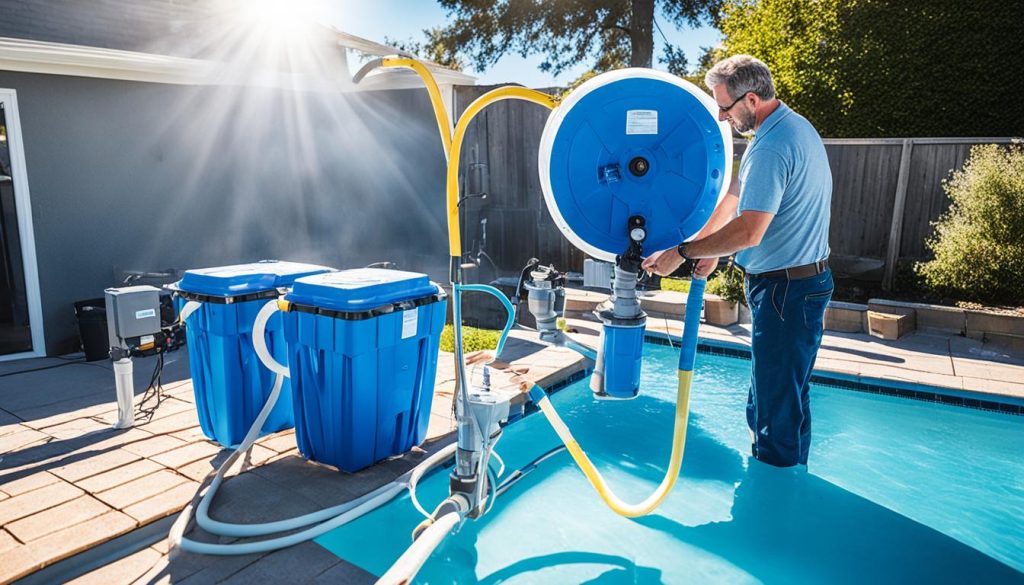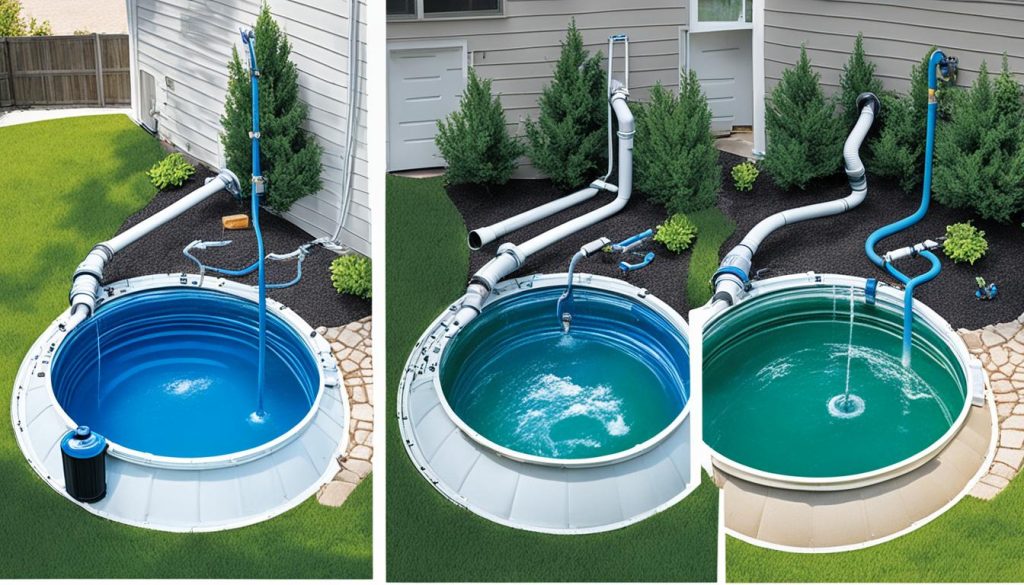Easy Steps: How to Drain Above Ground Pool
If you have an above ground pool that needs to be drained, you may be wondering how to tackle this task efficiently and safely. Improper draining techniques can not only damage your pool but also waste precious time and resources. In this step-by-step guide, I will walk you through the process of draining an above ground pool, whether you have a pump or not. By following these easy steps, you’ll be able to maintain your pool effectively and ensure its longevity.
Key Takeaways:
- Draining an above ground pool is an important maintenance task that should be done safely.
- Improper draining techniques can damage your pool and waste resources.
- Whether you have a pump or not, you can successfully drain your above ground pool by following easy steps.
- By properly maintaining your pool, you can ensure its longevity and enjoyment for years to come.
When Should You Drain an Above Ground Pool?
Knowing when to drain your above ground pool is essential for its proper maintenance. Several situations may require you to completely drain the pool:
- Water chemistry: If your pool’s water chemistry is beyond rebalancing, and it’s difficult to achieve the ideal levels despite repeated attempts, draining and replacing the water can be a practical solution.
- Structural repairs: In case your pool requires significant structural repairs, such as patching leaks or replacing damaged components, draining the pool ensures better access to the affected areas while minimizing potential water damage.
- Cold climate storage: If you have a smaller above ground swimming pool and live in a cold climate, draining and safely storing the pool during the winter months is crucial to prevent freezing and potential damage to the pool liner.
Regardless of the reason for draining your above ground pool, following the best practices for draining pool water is essential to protect the longevity and integrity of your pool.
Best Practices for Draining Pool Water
When preparing to drain your above ground pool, consider the following best practices:
- Have a water disposal plan: Before starting the draining process, ensure you have a proper plan for disposing of the water. Check with your local authorities for any regulations or guidelines regarding pool water disposal in your area.
- Lower chemical levels: Bring down your pool’s chemical levels to prevent any potential damage to the environment during water disposal. Test the water and adjust the chemical levels accordingly.
- Choose a mild, warm day: Drain your pool on a day with mild weather conditions. Warm temperatures facilitate the draining process and minimize the risk of damage to the pool liner.
- Turn off equipment: Before draining, make sure to turn off all pumps, filters, heaters, and automatic timers to avoid potential accidents or damage to the equipment.
By adhering to these best practices, you can ensure a smooth and safe draining process for your above ground pool.
How to Prepare an Above Ground Pool for Draining
Before you start draining your above ground pool, there are a few steps you need to take to ensure the process goes smoothly.
- Create a Water Disposal Plan: It’s important to have a plan in place for disposing of the pool water. Check with your local authorities to understand any regulations or guidelines regarding pool water disposal in your area.
- Adjust Chemical Levels: Bring down the chemical levels in your pool before draining. This will help protect the environment and prevent any potential damage that high chemical levels may cause.
- Wait for Mild, Warm Weather: Choose a period of mild, warm weather to drain your pool. Extreme temperatures can affect the stability of your pool liner, so it’s best to avoid draining during freezing cold or scorching hot conditions.
- Turn off Equipment: Before you begin draining, make sure to turn off all equipment such as pumps, filters, heaters, and automatic timers. This will prevent any accidental operation during the draining process.
By following these preparation steps, you can ensure a safe and successful draining process for your above ground pool.
- Know the Regulations: It’s important to check with local authorities for any regulations regarding pool water disposal.
- Adjust Chemical Levels: Lower the chemical levels in your pool before draining to protect the environment and prevent damage.
- Choose the Right Weather: Wait for mild, warm weather to drain your pool to avoid damage to the pool liner.
- Turn off Equipment: Before draining, remember to turn off pumps, filters, heaters, and automatic timers to prevent any accidents.
3 Ways to Drain an Above Ground Pool
When it comes to draining an above ground pool, there are three main methods you can choose from: siphoning water with a garden hose, using a submersible pump, or utilizing your pool’s drain adapter. Each method has its advantages depending on the amount of water you need to drain. In this section, I will provide a step-by-step guide for each method, helping you navigate through the pool draining process.
Siphoning Water with a Garden Hose
If you only need to partially drain your pool, siphoning water with a garden hose is a simple and cost-effective option. Here’s a step-by-step guide:
- Attach one end of the garden hose to a spigot or faucet that has running water.
- Submerge the other end of the hose completely in the pool, ensuring it fills with water.
- While keeping the hose submerged, remove the end from the pool and quickly cap it with your thumb.
- Place the capped end of the hose into a lower area where you want the water to drain.
- Release your thumb to create a siphon, and water will start flowing out of the pool through the hose.
Note: To prevent any potential contamination, do not use your mouth to start the siphon. Instead, use your thumb to quickly cap the hose.
Using a Submersible Pump
If you need to completely drain a larger pool, using a submersible pump can speed up the process. Here’s a step-by-step guide:
- Place the submersible pump in the pool, ensuring it is fully submerged.
- Connect a garden hose to the pump’s outlet. Make sure the hose is long enough to reach your desired drainage area.
- Plug in the pump and turn it on. The pump will start drawing water from the pool and discharging it through the hose.
- Monitor the water level in the pool and adjust the pump’s position if needed to ensure it continues to drain efficiently.
- Once the pool is completely drained, turn off the pump and disconnect it from the power source.
Utilizing Your Pool’s Drain Adapter
If your above ground pool has a drain adapter, you can use it to facilitate the draining process. Here’s a step-by-step guide:
- Locate the drain adapter on your pool, typically located near the bottom.
- Attach a garden hose to the drain adapter, ensuring a secure connection.
- Position the other end of the hose in the area where you want the water to drain.
- Open the drain valve on the adapter to start the flow of water.
- Monitor the draining process and make sure the hose remains in the right position to avoid any spills or flooding.
- Once the pool is drained, close the drain valve and remove the hose.
By following these step-by-step guides, you can successfully drain your above ground pool using the method that best suits your needs. Whether it’s siphoning with a garden hose, using a submersible pump, or utilizing your pool’s drain adapter, DIY pool draining methods give you the flexibility and convenience to maintain your pool properly.
| Method | Advantages | Disadvantages |
|---|---|---|
| Siphoning Water with a Garden Hose | Simple and cost-effective | Only suitable for partial draining |
| Using a Submersible Pump | Fast and efficient for complete draining | Requires purchasing or renting a pump |
| Utilizing Your Pool’s Drain Adapter | Easy and convenient if your pool has a drain adapter | May require additional equipment or accessories |
How to Drain an Above Ground Pool Without A Pump: Garden Hose Siphon Method
If you don’t have a pump and only need to partially drain your pool, you can use the garden hose siphon method as a DIY solution. This simple technique allows you to remove water from your above ground pool without the need for a pump.
Here’s how you can drain your above ground pool using the garden hose siphon method:
- Submerge the entire garden hose underwater in the pool.
- Once the hose is completely filled with water, remove one end of the hose from the pool while keeping the other end submerged.
- Ensure that the end of the hose you removed from the pool is lower than the pool’s water level. This creates a siphoning effect.
- Important: Do not let air enter the hose while setting up the siphon. If air gets in, you’ll need to repeat the process from the beginning.
- As the water flows out of the pool through the siphon, you can direct it to a suitable drainage area or a designated spot for water disposal.
By following these steps, you can successfully drain your above ground pool without the use of a pump. Remember to monitor the process closely and make sure the siphon remains consistent.
For a visual guide on setting up a garden hose siphon, refer to the image below:
| Advantages of the Garden Hose Siphon Method | Disadvantages of the Garden Hose Siphon Method |
|---|---|
|
|
How to Drain an Above Ground Pool With a Sump Pump
Draining an above ground pool can be a daunting task, especially if you need to completely drain it. However, using a sump pump can make the process quicker and more efficient. To drain your pool with a sump pump, you will need a submersible electric pump, a garden hose, and a shop vac (optional).
First, make sure the sump pump is submerged in the pool water. Connect one end of the garden hose to the outlet of the sump pump. If you have a shop vac, place it near the end of the hose to collect any remaining water.
Next, lead the other end of the garden hose to a suitable drainage area, ensuring that it is sloped downward to allow for proper water flow. Turn on the sump pump and monitor the water flow as it is being pumped out of your pool.
While the sump pump is draining the water, it’s important to keep an eye on the water level to prevent the pump from running dry. Once the pool is completely drained, turn off the sump pump and disconnect the garden hose. Your above ground pool is now ready for maintenance or storage.
- Investing Wisely: How Windows & Doors in Boost Property Value and Financial Health - April 24, 2025
- The Financial Impact of Personal Injuries: Why Legal Help Matters for Business Owners - April 16, 2025
- The Hidden Financial Costs of Domestic Assault: What Business Owners Need to Know - April 16, 2025














